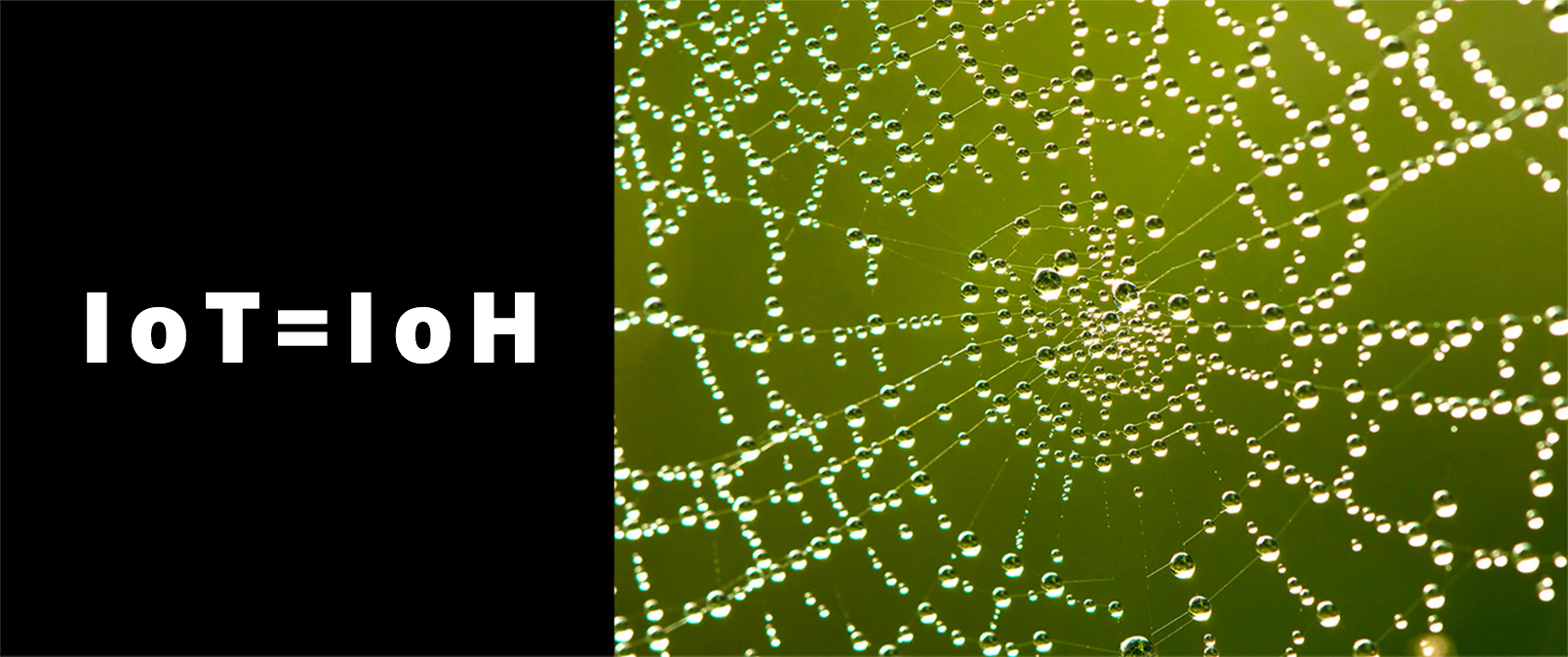A Future Where Every Thing Is Connected Over the Internet
IoT, the Internet of Things, is a phrase that is gaining a lot of attention recently. But what kind of technology is it really, and what will it mean for the future of society? We asked Professor Ken Sakamura of the University of Tokyo, who already back in the 1980s predicted a future society where all sorts of things would have built-in computers, and went on to grapple with the fundamental structure of that technology.
2016.07.20 UPDATE
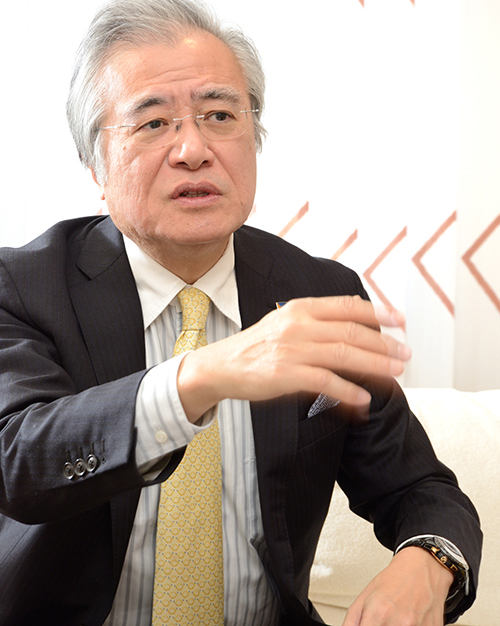
Ken Sakamura
Professor of Information Studies at the Graduate School of the University of Tokyo. Doctor of engineering, specialized in cyber architecture and information engineering. Leader of the TRON project, and chief of the YRP Ubiquitous Networking Laboratory. In 2015, he received the prestigious ITU 150 award from the International Telecommunication Union.
The Internet of Things
Since last year, the term “IoT” pops up increasingly frequently in newspapers and on news sites. The big IT companies are announcing new IoT-related services, and several new organizations have been launched to develop IoT-related standards. For non-professionals it may seem confusing. “What’s the difference from IT?” they may think, or believe it’s just another fancy acronym.
According to the American research firm Gartner’s “2015 Hype Cycle*1 for Emerging Technologies,” IoT, along with autonomous vehicles, were at their peak in 2015. That is to say, IoT is one of the buzzwords of the moment, and 2015 might be called “IoT Year Zero.”
But what is IoT? It is an acronym of the “Internet of Things,” and in a nutshell, it is a system for connecting various things around us to the Internet and controlling their exchange of information.
Take our current cars, for example. They are full of computers, and parts that used to be controlled mechanically are now controlled by computers. If we can connect all those computers to the Internet, we will be able to gather vehicle information in real time while driving. Then, by analyzing that information, we should be able to create more precise traffic jam information services, for instance. It also becomes possible to let our household appliances at home talk to each other – the air conditioner and the circulator, say – or different machines on a factory assembly line, which might lead to a revolution in manufacturing. Many other services and business opportunities can be imagined thanks to IoT.
“But isn’t that what they used to call ubiquitous computing?” some may object. Sure, IoT is basically the same idea as Ubiquitous Computing or Pervasive Computing or M2M (Machine to Machine) that were buzzwords a decade or so ago.
The term “Internet of Things” was coined by the British entrepreneur Kevin Ashton back in 1999, when he was working as an assistant brand manager for Procter & Gamble. While thinking of a mechanism to manage the logistics of goods and locations in the warehouse, he had the idea to use RFID tags (wireless identification tags) rather than bar codes to manage P&G’s supply chain, and invented the term for his image of connecting things over the Internet.
*1─A method devised by Gartner, Inc. of analyzing and positioning new technologies in the phases “Technology trigger,” “Peak of inflated expectations,” “Through of disillusionment,” “Slope of enlightenment” and “Plateau of productivity.”
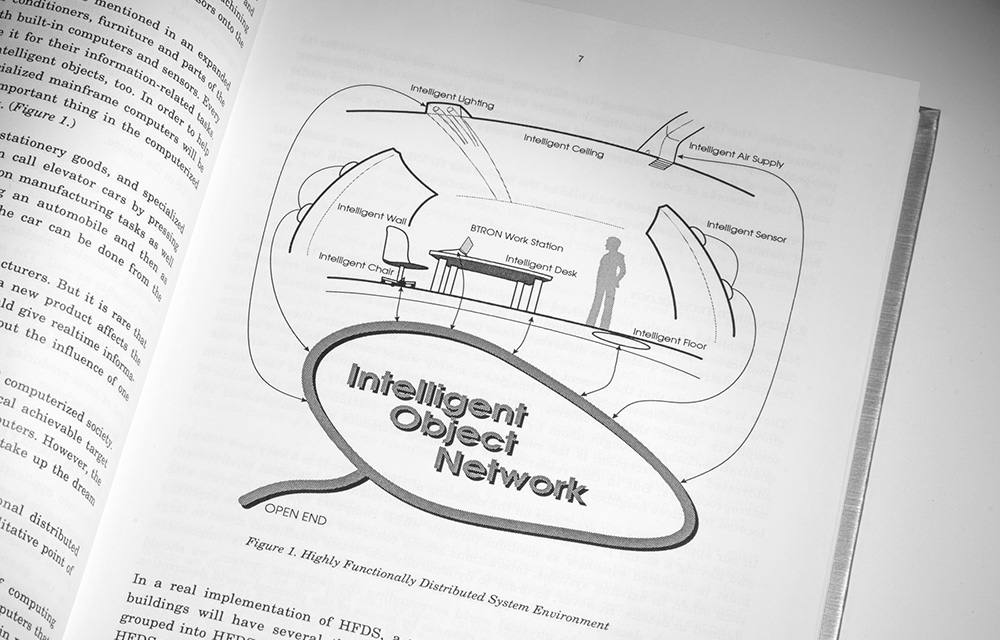
Image of a Highly Functionally Distributed System (HFDS) in the TRON specifications.
The Internet and Cloud Technologies behind IoT
Ubiquitous computing used to be a huge topic, like IoT is today, but then fell into the “Through of Disillusionment” in the hype cycle. Expectations ran high during the most fashionable phase, but the technology itself was still in its infancy and no concrete products or services were about to be released any time soon. It was a typical case of people getting disillusioned with a new technology before it had had the chance to spread in society. So will IoT also share the same fate? I don’t think so, precisely because IoT is the same as ubiquitous computing. That is an important point. If you think about it, it already has a long history, and in the meantime, the infrastructure of the Internet environment has been put in place and applied technologies have been developed. IoT is ubiquitous computing that has come round full circle and been restarted.
For example, we now have web search engines with the technology to handle the traffic and provide service even if millions of people access them simultaneously from all over the world. Communications companies have invested large sums in high-speed lines to improve the net environment. The semiconductor technologies that underlie the computers to be built into things have also evolved, and small, high-performance microprocessors have been developed. These changes have occurred gradually over the past ten years.
Therefore we know that if we now connect not just our smartphones and computers to the Internet, but also our automobiles, household appliances, industrial and medical equipment, and lots of other things as well, it is almost certainly going to work just fine. And that is why a future based on IoT is becoming a reality.
Nobody can deny the convenience of the Internet any more. The way of doing business has changed completely in the age of the Internet, and previously unimaginable services have seen the light of day. What is expected to happen in the age of IoT, when things start communicating with each other?
One area with high expectations is the utilization of Big Data. An enormous amount of data will be gathered on the cloud servers when the things around us are connected to the Internet. The things will take care of it by themselves, 24 hours a day, 365 days a year. Then, when that tremendous amount of accumulated information, or Big Data, is analyzed, various new discoveries are waiting to be made, researchers say.
Another area is automatic control. Situations that until now needed human judgments and operations, can be handled automatically in an optimal way when things are connected and exchange information. Just like the Internet transformed the whole way of manufacturing, IoT will surely make our daily lives more convenient, but it will also change them dramatically.
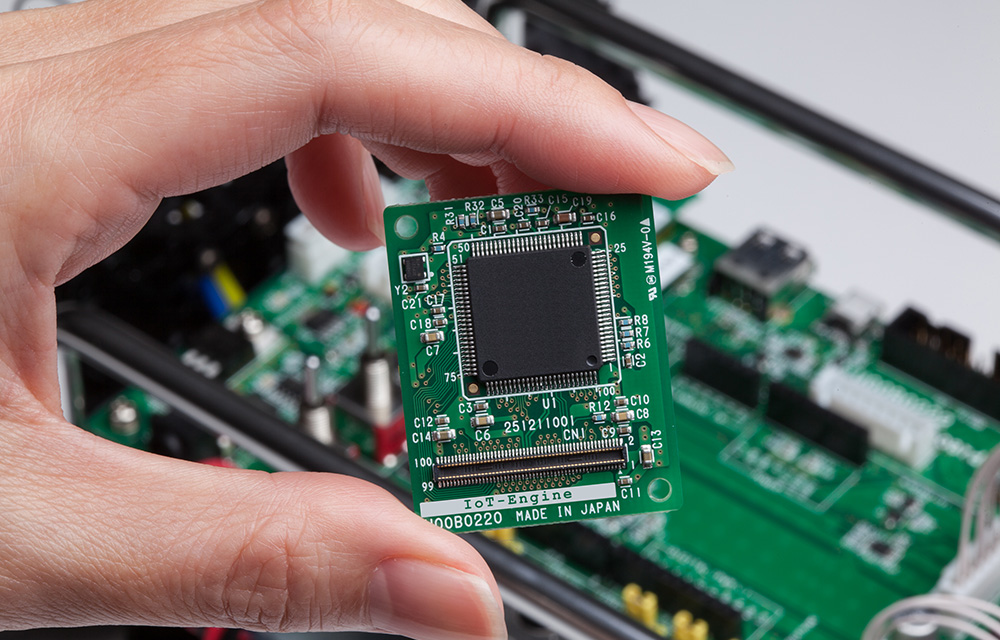
IoT-Engine is a platform for embedded systems to be built into consumer electronics products and connected to a cloud server.
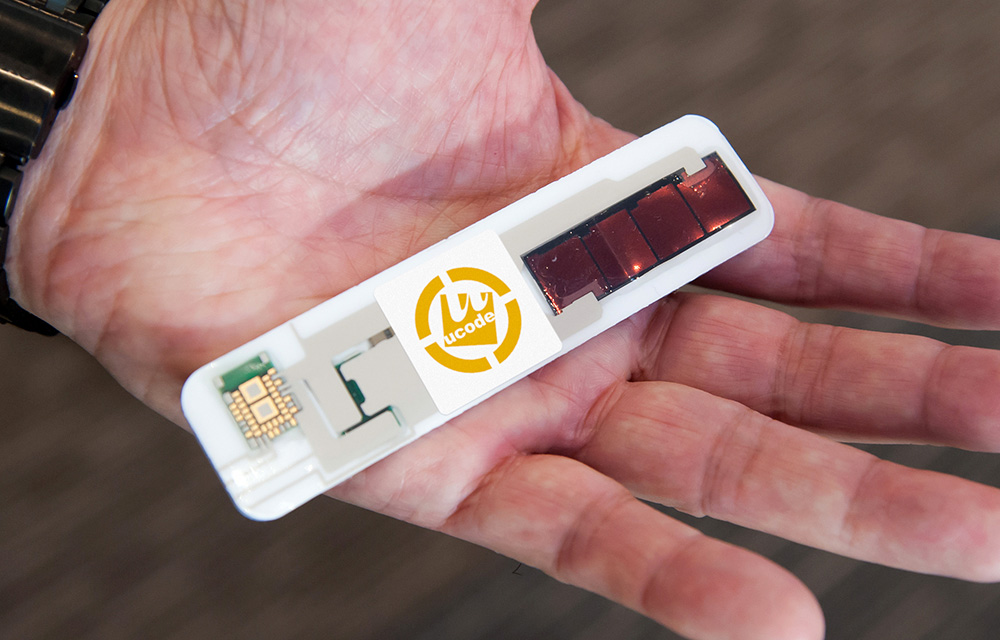
A “battery-less flexible beacon” developed by Fujitsu. Made in a highly flexible material, it can be attached to clothes and shoes to provide location-based services.
The West Aims to Take the IoT Initiative
Consequently, it becomes very important to create rules for IoT. The fact that people all over the world can send mail to each other over the Internet is because there are firmly established mail system standards and protocols. For example, if you connect thermometers and hygrometers to the net, and plot the collected data on a map, you can create extremely local weather forecasts for each region. But first you must define the data format: “a temperature value looks like this,” “a humidity value looks like this.” If everybody uses different standards, you can’t collect any Big Data.
In the case of automatic control, security is also important. Being able to remote control your household appliances is nice, but you definitely don’t want complete strangers to take control over the air conditioner in your home. In public facilities, it is necessary to determine in which areas users have free control, and where control is limited. (This is called “access control.”)
Currently, each country is aggressively promoting its own rules for the IoT age. Germany has the state-led “Industry 4.0”*2, while the American “Industrial Internet”*3 is promoted by a consortium of companies. Everyone is clamoring to take the initiative.
In cases like this, the Western nations straightaway raise their hands and say “Let us make the rules!” while Japan has a sorry tendency to say “You guys go ahead and make the rules, and we will follow.” I have always found that one of the more regrettable aspects of Japan. Just think about it: if you are allowed to define rules that everyone else must follow, you usually create them in your own favor. This is true of both Europe and the U.S., and they are highly unwilling to follow rules made by anybody else. That is why Japan has to quit its traditional wait-and-see attitude and aggressively try to claim the initiative. Making your own rules doesn’t mean isolating yourself, by any means. On the contrary, when the time comes to adjust and balance the various sets of rules, if you don’t bring your own set of rules to the table, you won’t even be allowed a seat.
That it what it means to take the initiative.
*2─The fourth industrial revolution. A project by the German government to promote innovative policies in the manufacturing industry. Based on a concept of “smart factories,” the factory production management system utilizes a network in order to optimize the manufacturing process.
*3─A project to create an open, global network by connecting industrial equipment, Big Data and humans. It is led by a consortium established by General Electric, Intel, Cisco, IBM and AT&T and aims to bring about a new industrial revolution through the fusion of hardware and software.
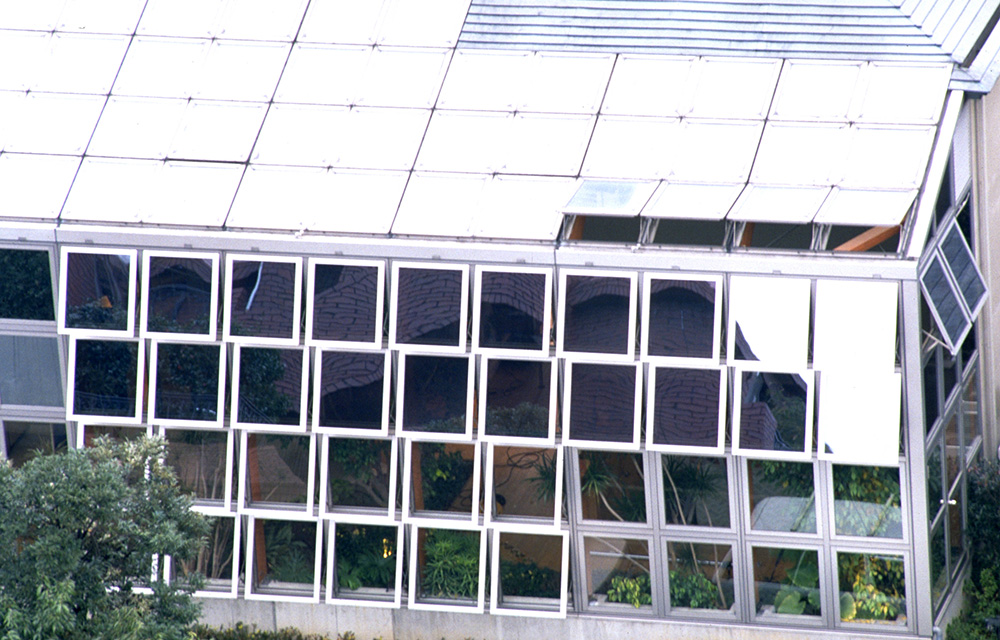
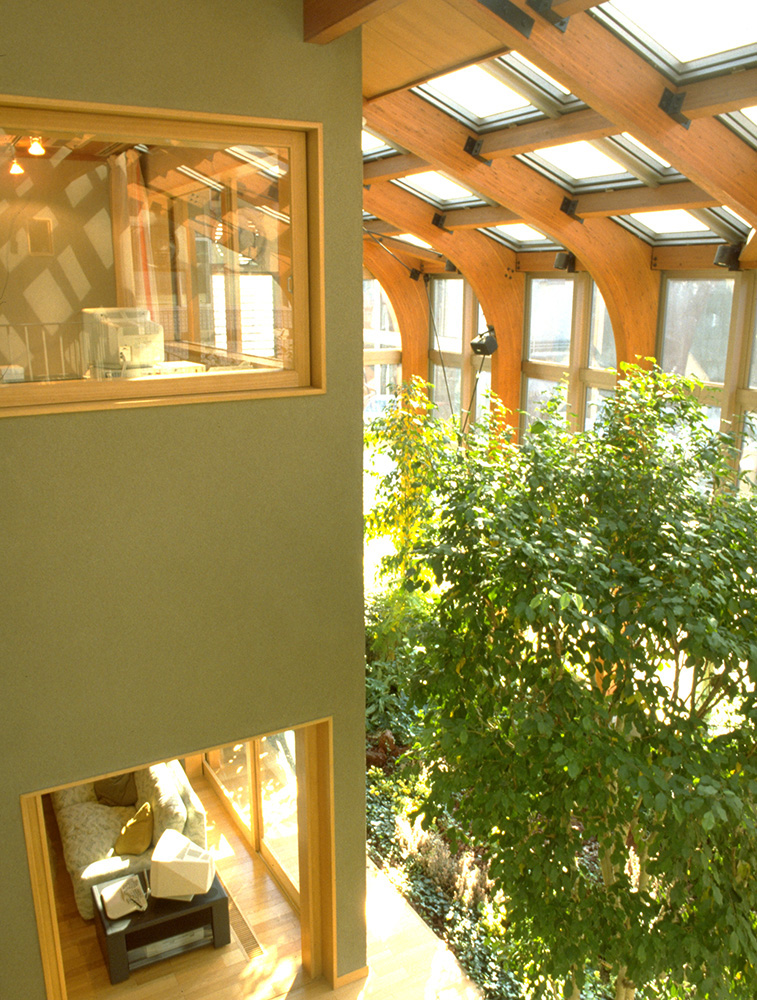
TRON Cyber Home in Nishi-Azabu, Tokyo. Built in 1989, it was partially open to the general public, and a large number of visitors were able to experience “a home of the future.”
The TRON Project and IoT
In the TRON project that I have been promoting since 1984, I predicted a future where various things around us would have computers inside that worked in cooperation with each other, and I have been trying to establish the necessary software and hardware foundations for this to happen. It is deeply emotional for me that IoT is the same concept that we in the TRON project used to call a “Highly Functionally Distributed System (HODS).” Time has finally caught up with TRON.
In 1989, I built the “TRON Cyber Home,” a house where all the equipment was connected via a network. The windows opened and closed automatically to adjust the temperature in the room, and the toilet had a built-in automatic blood pressure monitor and urine analyzer that sent data to the family doctor’s computer over a dedicated digital line. This was several years before the Internet was opened to the general public, but I was already convinced the time would come when every home would be able to send and receive data at low cost.
That house was truly a precursor to IoT. The big difference was that back then there was nothing like the wireless LAN communications we have today; we had to draw cables all through the house and connect them to a computer room in the basement.
In 2005, in collaboration with Toyota Homes, I built a future home called PAPI for EXPO 2005 AICHI JAPAN. By then, there was plenty of Internet technologies to use, and various types of information inside the house could be accessed and controlled from mobile terminals with touch-screens, a kind of forerunners to smartphones. There was even a system for supplying power from Toyota’s hybrid cars in the event of a power failure.
The small computers that are built into things are called “embedded systems,” and they were an important research topic from the very beginning of the TRON project. As opposed to standard computers that are used for information processing and where processing capacity is the main priority, in the world of embedded systems smallness, low power consumption, and light programs are more important. The CPUs and graphic functions of personal computers have become increasingly high-performance and the size of memories and hard disks has grown bigger and bigger, but embedded systems have evolved in a different way. An operating system I designed called ITRON (Industrial TRON) is widely used for embedded systems in mobile phones, consumer electronics products, industrial equipment, etc.

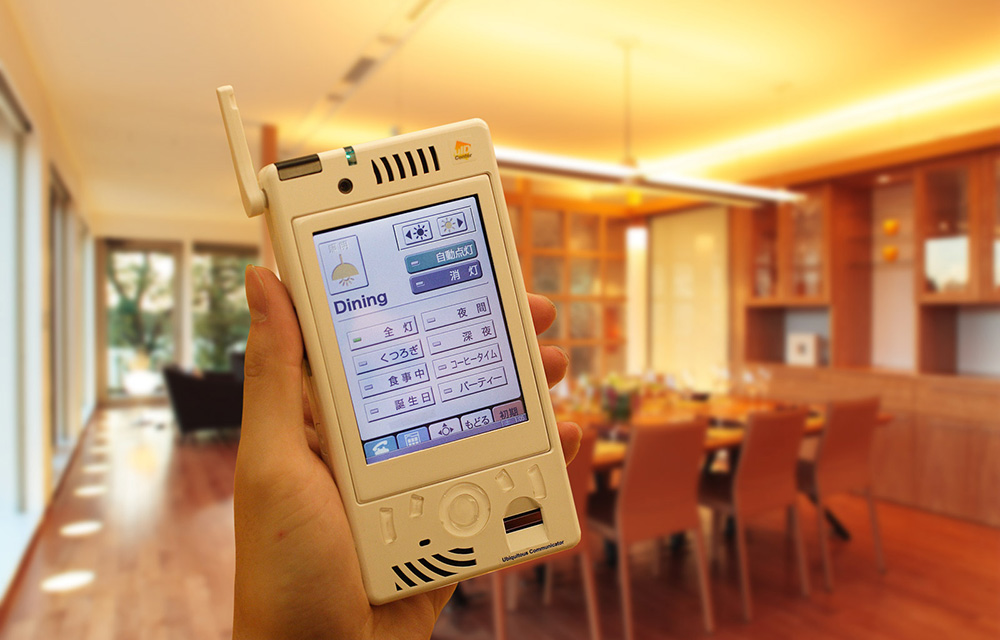
The dream home PAPI built in 2005 by Toyota in Nagakute city in Aichi prefecture, and was open to the general public during EXPO 2005 AICHI JAPAN. Various devices inside PAPI were controlled with touch-screen mobile terminals.
What is required in the IoT age is these embedded computers. If you were to embed a 100,000 yen processor with smartphone-quality specifications in every household appliance, piece of furniture, floor and ceiling, the cost would be outrageous. With TRON, we use small and light computers in the embedded systems and connect them to a cloud server over the Internet. We then let the cloud server handle the heavy processing, such as security.
Aggregate Computing – the Future Shape of IoT
Today’s web services, like search engines and SNS services, are free of charge for anyone to use. The most profitable Internet companies give away their services for free and get compensated by other means.
On the other hand, there are also music streaming services that let you listen to as many songs as you like for a fixed fee each month. Even if you don’t listen to a single song, you still have to pay the monthly fee. Business models that nobody had imagined just a few years ago are now commonplace. Even greater changes may occur in the age of IoT.
Say, for example, that you can get a self-driving vehicle basically for free. While you are driving, all data are collected and sent to the manufacturer over the net, and then you pay a service charge each month according to your usage.
Books could also be free to read. But as soon as you find it the tiniest bit funny or interesting, a wearable computer will pick up on your emotions and send the data to the publisher, who will then charge you according to the value of your enjoyment. How about that?
In other words, it becomes a world where things themselves are all free, but you have to compensate the companies for using them. Manufacturers that currently earn their profits from making and selling products may have to change their business model. When you think about it, the only time they can earn revenue from a product today is the first time it is sold. In the IoT world, the manufacturer and the user stay in contact by means of the product. It is a business model based on making people use things, rather than on making them buy things. It may even lead to greater profits than when simply selling things.
In that world, measuring becomes an important part of IoT. From Big Data gathered through monitoring the operation information of industrial equipment, we might learn that a particular vibration is a sign of a breakdown, for instance. By gathering massive amounts of measurement data about the whole human body or the environment, we may make new discoveries that have long gone unnoticed. The research in artificial intelligence and deep learning*4 has also made huge progress, and we have great expectations of the fruits of combining those fields with Big Data. And then, the discoveries and achievements will be fed back to society via IoT-controlled computers. Data-gathering sensors will play an ever greater role.
Distributed but cooperating computers built into things and connected to the Internet will offer a wide range of new services that will make our lives richer and more convenient. This is what I call “aggregate computing”; “aggregate” in the sense of “whole,” that is. This, I believe, is the true shape of the IoT to come.
*4─A machine learning process using neural networks modeled on the human brain. This approach has recently made dramatic progress in the field of image recognition and is gaining a lot of attention.
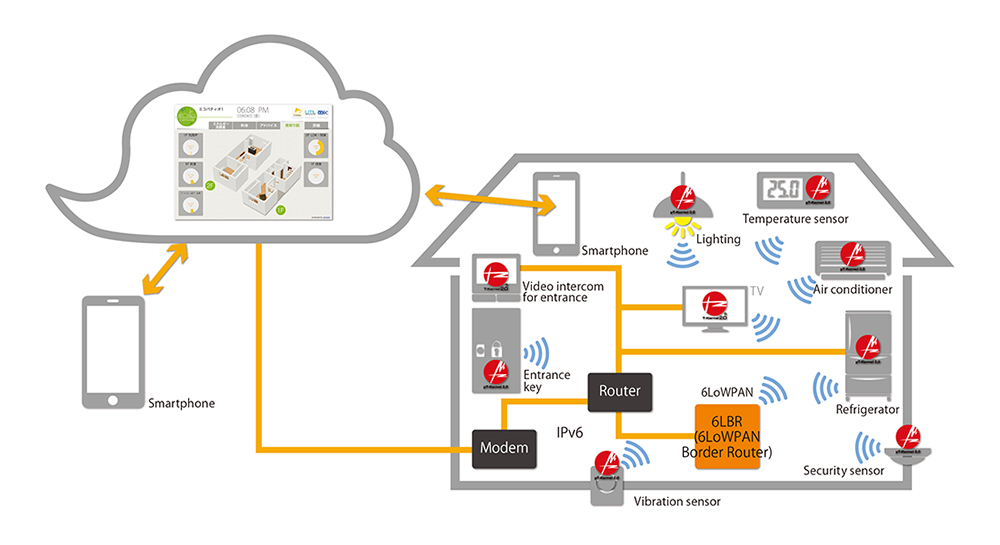
Image of a smart house for the IoT age. Information from various sensors embedded in the household appliances are collected by a cloud server that feeds back optimal control.
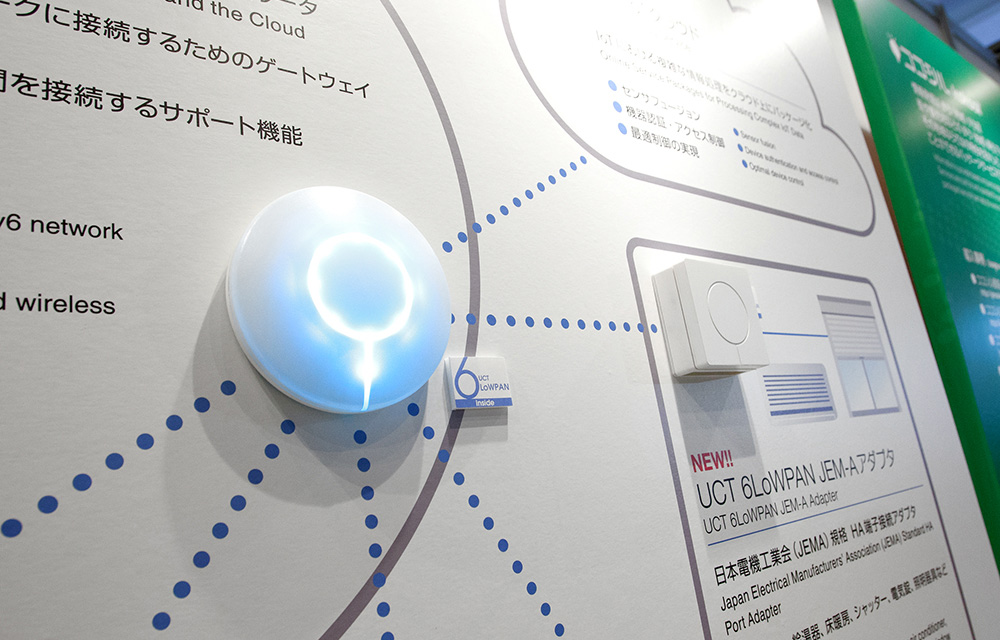
The “Border Router” connects everything in the house to the cloud. It is compatible with 6LoWPAN (IPv6 over Low-power Wireless Personal Area Networks), the likely protocol of the IoT age.





